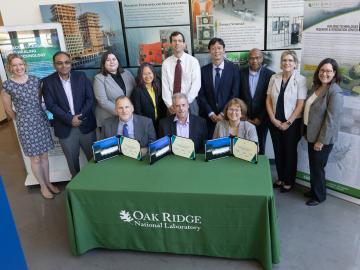
Filter News
Area of Research
- Advanced Manufacturing (6)
- Biology and Environment (32)
- Building Technologies (1)
- Computational Biology (1)
- Computational Engineering (3)
- Computer Science (14)
- Electricity and Smart Grid (1)
- Energy Science (58)
- Functional Materials for Energy (2)
- Fusion and Fission (7)
- Fusion Energy (8)
- Isotopes (20)
- Materials (74)
- Materials Characterization (2)
- Materials for Computing (12)
- Materials Under Extremes (1)
- Mathematics (1)
- National Security (14)
- Neutron Science (22)
- Nuclear Science and Technology (13)
- Nuclear Systems Modeling, Simulation and Validation (1)
- Quantum information Science (5)
- Supercomputing (66)
News Type
News Topics
- (-) Advanced Reactors (29)
- (-) Biomedical (45)
- (-) Clean Water (23)
- (-) Computer Science (135)
- (-) Isotopes (42)
- (-) Materials (116)
- (-) Molten Salt (8)
- 3-D Printing/Advanced Manufacturing (106)
- Artificial Intelligence (71)
- Big Data (46)
- Bioenergy (69)
- Biology (78)
- Biotechnology (23)
- Buildings (53)
- Chemical Sciences (65)
- Composites (28)
- Coronavirus (34)
- Critical Materials (25)
- Cybersecurity (27)
- Education (3)
- Element Discovery (1)
- Emergency (2)
- Energy Storage (93)
- Environment (139)
- Exascale Computing (27)
- Fossil Energy (2)
- Frontier (28)
- Fusion (37)
- Grid (50)
- High-Performance Computing (69)
- Hydropower (8)
- Irradiation (3)
- ITER (7)
- Machine Learning (41)
- Materials Science (109)
- Mathematics (8)
- Mercury (9)
- Microelectronics (1)
- Microscopy (42)
- Nanotechnology (50)
- National Security (43)
- Neutron Science (98)
- Nuclear Energy (71)
- Partnerships (38)
- Physics (47)
- Polymers (29)
- Quantum Computing (22)
- Quantum Science (51)
- Security (20)
- Simulation (32)
- Software (1)
- Space Exploration (13)
- Statistics (2)
- Summit (34)
- Transportation (85)
Media Contacts

A team of researchers used the Frontier supercomputer and a new methodology for conducting a genome-wide association study to earn a finalist nomination for the Association for Computing Machinery’s 2024 Gordon Bell Prize for outstanding

Researchers led by the University of Melbourne, Australia, have been nominated for the Association for Computing Machinery’s 2024 Gordon Bell Prize in supercomputing for conducting a quantum molecular dynamics simulation 1,000 times greater in size and speed than any previous simulation of its kind.

Researchers have developed and 3D printed the lightest crack-free alloy capable of operating without melting at temperatures above 2,400 degrees Fahrenheit, which could enable additively manufactured turbine blades to better handle extreme temperatures, reducing the carbon footprint of gas turbine engines such as those used in airplanes.

The Advanced Plant Phenotyping Laboratory at ORNL utilizes robotics, multi-modal imaging, and AI to enhance understanding of plant genetics and interactions with microbes. It aims to connect genes to traits for advancements in bioenergy, agriculture, and climate resilience. Senior scientist Larry York highlights the lab's capabilities and the insights from a new digital underground imaging system to improve biomass feedstocks for bioenergy and carbon storage.

A new technology to continuously place individual atoms exactly where they are needed could lead to new materials for devices that address critical needs for the field of quantum computing and communication that cannot be produced by conventional means.

A study led by the Department of Energy’s Oak Ridge National Laboratory details how artificial intelligence researchers created an AI model to help identify new alloys used as shielding for housing fusion applications components in a nuclear reactor. The findings mark a major step towards improving nuclear fusion facilities.

Distinguished materials scientist Takeshi Egami has spent his career revealing the complex atomic structure of metallic glass and other liquids — sometimes sharing theories with initially resistant minds in the scientific community.
After retiring from Y-12, Scott Abston joined the Isotope Science and Engineering Directorate to support isotope production and work with his former manager. He now leads a team maintaining critical equipment for medical and space applications. Abston finds fulfillment in mentoring his team and is pleased with his decision to continue working.

A team led by scientists at ORNL identified and demonstrated a method to process a plant-based material called nanocellulose that reduced energy needs by a whopping 21%, using simulations on the lab’s supercomputers and follow-on analysis.

Flexcon Global has exclusively licensed two patented inventions to manufacture a self-healing barrier film from ORNL for research and development purposes. The film can be incorporated into vacuum insulation panels to increase the efficiency of buildings during retrofits. Under a cooperative research and development agreement that began in 2021, Flexcon and ORNL have been exploring the capabilities of the technology and fine-tuning its properties.


